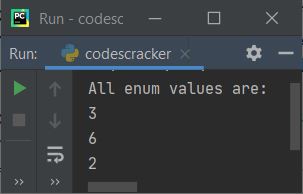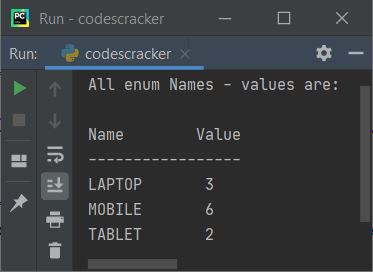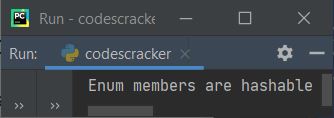- Python Basics
- Python Tutorial
- Python Applications
- Python Versions
- Python environment setup
- Python Basic Syntax
- Python end (end=)
- Python sep (sep=)
- Python Comments
- Python Identifiers
- Python Variables
- Python Operators
- Python Ternary Operator
- Python Operator Precedence
- Python Control and Decision
- Python Decision Making
- Python if elif else
- Python Loops
- Python for Loop
- Python while Loop
- Python break Statement
- Python continue Statement
- Python pass Statement
- Python break vs. continue
- Python pass vs. continue
- Python Built-in Types
- Python Data Types
- Python Lists
- Python Tuples
- Python Sets
- Python frozenset
- Python Dictionary
- List vs. Tuple vs. Dict vs. Set
- Python Numbers
- Python Strings
- Python bytes
- Python bytearray
- Python memoryview
- Python Misc Topics
- Python Functions
- Python Variable Scope
- Python Enumeration
- Python import Statement
- Python Modules
- Python operator Module
- Python os Module
- Python Date and Time
- Python Exception Handling
- Python File Handling
- Python Advanced
- Python Classes and Objects
- Python @classmethod Decorator
- Python @staticmethod Decorator
- Python Class vs. Static Method
- Python @property Decorator
- Python Keywords
- Python Keywords
- Python and
- Python or
- Python not
- Python True
- Python False
- Python None
- Python in
- Python is
- Python as
- Python with
- Python yield
- Python return
- Python del
- Python from
- Python lambda
- Python assert
- Python Built-in Functions
- Python All Built-in Functions
- Python print() Function
- Python input() Function
- Python int() Function
- Python len() Function
- Python range() Function
- Python str() Function
- Python ord() Function
- Python chr() Function
- Python read()
- Python write()
- Python open()
- Python Examples
- Python Examples
Python enumerations
This article is created to provide you with an easy way to learn "enum" (enumeration) in Python with the help of a practical example. This article deals with:
- Definition of enumerations in Python
- Enumeration Methods and Properties
- Implementation of enumeration methods and properties as an example
- Enumeration implementation example
- Print all enumeration values using "enum" iteration
- Print all the enumeration items in name-value pairs
Definition of enumerations in Python
Enumeration in Python is simply a collection of symbolic names that are bound to unique and constant values. An enumeration in Python can be iterated. The example to show how enumeration in Python can be iterated is shown later on in this page.
The "enum" module is used to implement enumeration in Python. And classes are used to create enumerations, like shown in the code block given below:
from enum import Enum class OrderCount(Enum): LAPTOP = 3 MOBILE = 6 TV = 2
Note: In the above example, I've written all the enum members in UPPERCASE letters because enumeration is used to represent constants. And it is better practice to write any variable that holds constant values in uppercase. Otherwise, it is up to you whether to use uppercase, lowercase, or a combination of the two.
In the above example of enumeration:
- The class named "OrderCount" is an enumeration (or enum in short).
- The attributes OrderCount.LAPTOP, OrderCount.MOBILE, etc. are enumeration members that are functional constants.
- As you can see, enumerations are made up of a name and a value pair.
- The name of OrderCount.LAPTOP is LAPTOP, and the value of OrderCount.LAPTOP is 3.
Enumeration Methods and Properties
Now we've got to learn these 5 things that are most widely used in Python enumerations. I kept the above short block of code in mind while evaluating these things with the help of an example to give you a clear idea of the subject.
- repr() returns the official string representation of the value that is being passed. For example, "print(repr(OrderCount.LAPTOP))" produces "<OrderCount.LAPTOP: 3>" on the output console from the previous example. That is, enumeration members have human-readable string representations. But using "repr()," we will be able to fetch the official or the detailed version of the string.
- type() returns the enumeration's name that the enumeration member belongs to. For example, "print(type(OrderCount.LAPTOP))" produces "<enum 'OrderCount'>" on the output console. That shows the "OrderCount.LAPTOP" enum member belongs to the "OrderCount" enum.
- isinstance() returns true if the specified object (the first argument) is an instance of the class (the second argument). Otherwise, it returns false. For example, "print(isinstance(OrderCount.LAPTOP, OrderCount))" produces true on the output console since "OrderCount.LAPTOP" (the first argument) is an instance of the class named "OrderCount" (the second argument).
- name: In Python, "enum" members have a property that contains the name of the item. For example, "print(OrderCount.LAPTOP.name)" produces "LAPTOP" on the output. That is the name of the "enum" item.
- value: In Python, "enum" members also have a property that contains the value of the item. For example, "print(OrderCount.LAPTOP.value)" produces 3 on the output.
Implementation of enumeration methods and properties as an example
The program given below uses repr(), type(), isinstance(), name, and value in one single program. Let's have a look at the program given below and understand it in a practical way after seeing its sample output:
from enum import Enum class OrderCount(Enum): LAPTOP = 3 MOBILE = 6 TV = 2 print(repr(OrderCount.LAPTOP)) print(type(OrderCount.LAPTOP)) print(isinstance(OrderCount.LAPTOP, OrderCount)) print(OrderCount.LAPTOP.name) print(OrderCount.LAPTOP.value)
Here is its sample output:

Enumeration implementation example
Now let's take a look at the program given below that demonstrates enumeration in a practical way. This is basically a modified version of the previous program. Since this program includes a description of each output:
from enum import Enum class OrderCount(Enum): LAPTOP = 3 MOBILE = 6 TV = 2 print("The string representation of enum member \"OrderCount.MOBILE\" is:", OrderCount.MOBILE) print("The \"repr\" representation of enum member \"OrderCount.MOBILE\" is:", repr(OrderCount.MOBILE)) print("The name of enum member \"OrderCount.MOBILE\" is:", OrderCount.MOBILE.name) print("The value of enum member \"OrderCount.MOBILE\" is:", OrderCount.MOBILE.value)
The snapshot given below shows its sample output:

Print all enumeration values using "enum" iteration
This example is created in such a way that it will create an enumeration and then print all the values of the enumeration:
from enum import Enum class OrderCount(Enum): LAPTOP = 3 MOBILE = 6 TV = 2 print("All enum values are:") for val in OrderCount: print(val.value)
This program produces the output that looks like:

Print all the enumeration items in name-value pairs
Basically, this is a modified and improved version of the previous program. This program prints all enumeration items' names along with their values in an organized way:
from enum import Enum class OrderCount(Enum): LAPTOP = 3 MOBILE = 6 TABLET = 2 print("All enum Names - values are:") print("\nName\t\tValue") print("-----------------") for val in OrderCount: print(val.name, "\t\t", val.value)
And the snapshot given below shows the sample output produced by the above Python program:

Enumeration members are hashable
Since enumeration members in Python are hashable, we can use them in dictionaries or sets. If any object never changes its value during its lifetime, then the object is called a hashable object. In other words, hashability enables an object to be usable as a dictionary key and a set member.
The example program given below illustrates that all the things said here to support enum members are hashable.
from enum import Enum class Product(Enum): MOBILE = 3 LAPTOP = 6 TABLET = 5 product_dict = {} product_dict[Product.MOBILE] = 'white' product_dict[Product.LAPTOP] = 'black' if product_dict == {Product.MOBILE: 'white', Product.LAPTOP: 'black'}: print("Enum members are hashable") else: print("Enum members are not hashable")
The image below shows an example of the output this Python program produces:

« Previous Tutorial Next Tutorial »